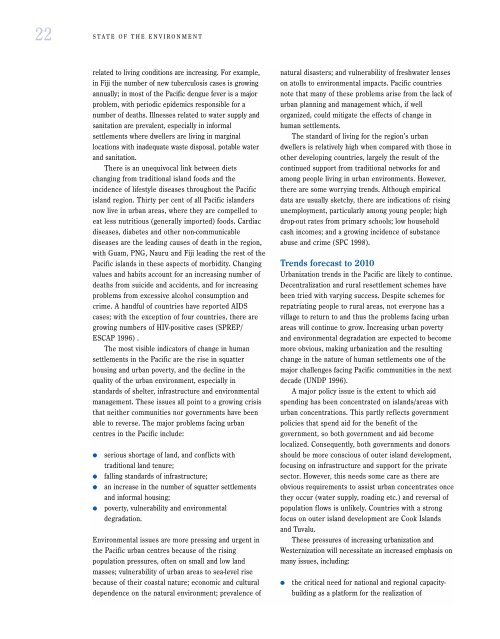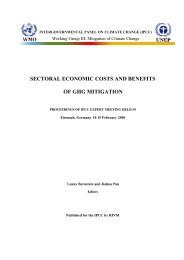Pacific Islands Environment Outlook - UNEP
Pacific Islands Environment Outlook - UNEP
Pacific Islands Environment Outlook - UNEP
Create successful ePaper yourself
Turn your PDF publications into a flip-book with our unique Google optimized e-Paper software.
22<br />
STATE OF THE ENVIRONMENT<br />
related to living conditions are increasing. For example,<br />
in Fiji the number of new tuberculosis cases is growing<br />
annually; in most of the <strong>Pacific</strong> dengue fever is a major<br />
problem, with periodic epidemics responsible for a<br />
number of deaths. Illnesses related to water supply and<br />
sanitation are prevalent, especially in informal<br />
settlements where dwellers are living in marginal<br />
locations with inadequate waste disposal, potable water<br />
and sanitation.<br />
There is an unequivocal link between diets<br />
changing from traditional island foods and the<br />
incidence of lifestyle diseases throughout the <strong>Pacific</strong><br />
island region. Thirty per cent of all <strong>Pacific</strong> islanders<br />
now live in urban areas, where they are compelled to<br />
eat less nutritious (generally imported) foods. Cardiac<br />
diseases, diabetes and other non-communicable<br />
diseases are the leading causes of death in the region,<br />
with Guam, PNG, Nauru and Fiji leading the rest of the<br />
<strong>Pacific</strong> islands in these aspects of morbidity. Changing<br />
values and habits account for an increasing number of<br />
deaths from suicide and accidents, and for increasing<br />
problems from excessive alcohol consumption and<br />
crime. A handful of countries have reported AIDS<br />
cases; with the exception of four countries, there are<br />
growing numbers of HIV-positive cases (SPREP/<br />
ESCAP 1996) .<br />
The most visible indicators of change in human<br />
settlements in the <strong>Pacific</strong> are the rise in squatter<br />
housing and urban poverty, and the decline in the<br />
quality of the urban environment, especially in<br />
standards of shelter, infrastructure and environmental<br />
management. These issues all point to a growing crisis<br />
that neither communities nor governments have been<br />
able to reverse. The major problems facing urban<br />
centres in the <strong>Pacific</strong> include:<br />
●<br />
●<br />
●<br />
●<br />
serious shortage of land, and conflicts with<br />
traditional land tenure;<br />
falling standards of infrastructure;<br />
an increase in the number of squatter settlements<br />
and informal housing;<br />
poverty, vulnerability and environmental<br />
degradation.<br />
<strong>Environment</strong>al issues are more pressing and urgent in<br />
the <strong>Pacific</strong> urban centres because of the rising<br />
population pressures, often on small and low land<br />
masses; vulnerability of urban areas to sea-level rise<br />
because of their coastal nature; economic and cultural<br />
dependence on the natural environment; prevalence of<br />
natural disasters; and vulnerability of freshwater lenses<br />
on atolls to environmental impacts. <strong>Pacific</strong> countries<br />
note that many of these problems arise from the lack of<br />
urban planning and management which, if well<br />
organized, could mitigate the effects of change in<br />
human settlements.<br />
The standard of living for the region’s urban<br />
dwellers is relatively high when compared with those in<br />
other developing countries, largely the result of the<br />
continued support from traditional networks for and<br />
among people living in urban environments. However,<br />
there are some worrying trends. Although empirical<br />
data are usually sketchy, there are indications of: rising<br />
unemployment, particularly among young people; high<br />
drop-out rates from primary schools; low household<br />
cash incomes; and a growing incidence of substance<br />
abuse and crime (SPC 1998).<br />
Trends forecast to 2010<br />
Urbanization trends in the <strong>Pacific</strong> are likely to continue.<br />
Decentralization and rural resettlement schemes have<br />
been tried with varying success. Despite schemes for<br />
repatriating people to rural areas, not everyone has a<br />
village to return to and thus the problems facing urban<br />
areas will continue to grow. Increasing urban poverty<br />
and environmental degradation are expected to become<br />
more obvious, making urbanization and the resulting<br />
change in the nature of human settlements one of the<br />
major challenges facing <strong>Pacific</strong> communities in the next<br />
decade (UNDP 1996).<br />
A major policy issue is the extent to which aid<br />
spending has been concentrated on islands/areas with<br />
urban concentrations. This partly reflects government<br />
policies that spend aid for the benefit of the<br />
government, so both government and aid become<br />
localized. Consequently, both governments and donors<br />
should be more conscious of outer island development,<br />
focusing on infrastructure and support for the private<br />
sector. However, this needs some care as there are<br />
obvious requirements to assist urban concentrates once<br />
they occur (water supply, roading etc.) and reversal of<br />
population flows is unlikely. Countries with a strong<br />
focus on outer island development are Cook <strong>Islands</strong><br />
and Tuvalu.<br />
These pressures of increasing urbanization and<br />
Westernization will necessitate an increased emphasis on<br />
many issues, including:<br />
●<br />
the critical need for national and regional capacitybuilding<br />
as a platform for the realization of

















